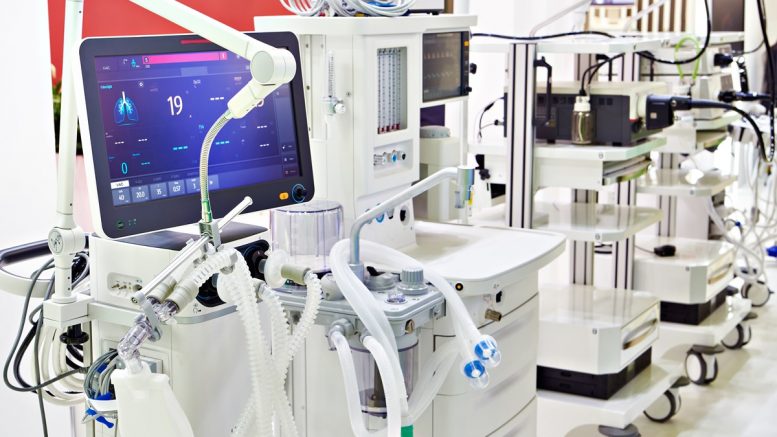As the healthcare industry increasingly relies on technology, the use of lithium-ion batteries has become widespread across medical devices and everyday tools. While these lithium-ion batteries are known for their efficiency and portability, they also introduce significant fire risks. In healthcare settings, where patient safety and uninterrupted operations are paramount, managing these risks becomes a critical consideration.
Understanding the fire hazards of lithium-ion batteries
Lithium-ion batteries are widely used due to their compact design and ability to store large amounts of energy. However, when these batteries become damaged, by overcharging, or exposure to extreme temperatures, for example, they can enter a state called ‘thermal runaway.’ This process occurs when the battery’s temperature rises uncontrollably, potentially leading to fires or even explosions. The internal electrolytes of the battery are highly flammable, and once ignited, fires are not only difficult to extinguish but also prone to reigniting, presenting a significant safety challenge.
In healthcare settings, where lithium-ion batteries can power essential equipment, such as ventilators, monitors, and mobile workstations, the possibility of fire-related emergencies requires attention. The complexity of managing these hazards is magnified by the critical need to ensure patient safety and the continuous operation of life-saving technologies.
Why healthcare facilities face heightened lithium-ion battery risks
Healthcare facilities are particularly vulnerable to the risks posed by lithium-ion batteries for several reasons. First, these environments are often saturated with various electronic devices. Medical-grade equipment, such as infusion pumps, patient monitoring systems, and portable defibrillators, can rely on rechargeable lithium-ion batteries to function. Additionally, personal devices like smartphones, tablets, and laptops carried by patients, staff, and visitors add to the total number of batteries present in the facility. This concentration of devices increases the likelihood of a fire, especially if they are improperly maintained or damaged.
Moreover, the nature of healthcare makes emergency response more complicated. Many patients have limited mobility or cognitive impairments, making swift evacuations challenging in the event of a fire. For healthcare workers, the need to prioritise patient care over rapid evacuation can further slow emergency responses. In environments like intensive care units, neonatal wards, or operating rooms, even brief disruptions can have life-threatening consequences.
Essential fire safety measures for lithium-ion batteries in healthcare environments
Given the distinct challenges presented by lithium-ion batteries in healthcare settings, it’s essential facilities implement targeted fire safety strategies. The following steps are crucial to mitigating the risks:
Installing effective lithium-ion-specific fire extinguishers
Different types of fires require specific fire extinguishers for effective response. During a fire risk assessment, it’s vital that the unique hazards posed by lithium-ion batteries are identified as a potential threat. As a result, it becomes essential for healthcare facilities to address this risk by installing fire extinguishers specifically designed for lithium-ion battery fires. The most effective way to extinguish this type of fire is by choosing a lithium-ion battery fire extinguisher that’s able to tackle the flames of the fire and halt thermal runaway in its tracks, by drawing heat from the battery.
This proactive approach ensures that the facility is equipped to handle the distinct dangers of lithium-ion battery fires and stop the spread to other battery cells.
Routine inspection and maintenance protocols
To minimise fire risks, it’s important healthcare facilities adopt strict maintenance routines for all lithium-ion battery-powered devices. Regular inspections should check for signs of wear, damage, or swelling in batteries, which can be indicators of a failure. Routine monitoring can prevent many fire incidents by addressing risks before they escalate.
Ensuring safe charging and storage practices
The proper handling of lithium-ion batteries is critical. It’s important healthcare personnel are trained in best practices for charging devices, such as unplugging equipment once fully charged and avoiding overcharging. Also, charging stations should be placed in cool, well-ventilated areas, away from flammable materials. Additionally, storing devices properly when not in use – keeping them out of hot or humid environments – can further reduce the risk of the battery overheating and subsequent fires.
Staying compliant with fire safety regulations
Adhering to fire safety regulations is essential for healthcare facilities, especially given the specific risks that lithium-ion batteries present. Under the Regulatory Reform (Fire Safety) Order 2005 in the UK, healthcare settings should now consider and document the presence of lithium-ion batteries in fire risk assessments. The designated responsible person in the facility is tasked with ensuring all necessary measures are in place, from updating fire safety protocols to conducting regular fire risk assessments. Compliance not only enhances safety but also helps avoid legal repercussions stemming from potential fire-related incidents.
Collaborating with fire safety experts
Healthcare facilities can collaborate with fire safety professionals to establish and maintain robust fire safety protocols. This often involves working with local fire services to ensure compliance with the latest regulations and safety standards, as well as having qualified fire safety engineers conduct compulsory routine maintenance, such as the annual servicing of fire extinguishers. By taking this proactive approach, healthcare establishments can continuously improve their safety measures and remain well-prepared for any potential fire emergencies.
The importance of education and preparedness
Effective fire safety strategies extend beyond installing equipment and following procedures. It’s essential that healthcare staff are educated about the specific dangers posed by lithium-ion batteries and trained in emergency response protocols. Regular drills and ongoing training sessions help ensure all employees are prepared to act quickly and effectively in the event of a fire.
Additionally, patients and visitors should be informed of safe practices when using their personal electronic devices. Signage, pamphlets, or verbal instructions can be helpful in raising awareness and reducing potential hazards.
Ensuring patient and facility safety in an era of advanced technology
As lithium-ion batteries continue to power more of the devices used in healthcare settings, managing the risks they pose becomes increasingly critical. It’s imperative healthcare facilities prioritise fire safety by implementing specialised solutions, maintaining rigorous inspection routines, and ensuring compliance with regulations. Equally important is the need for continuous education and preparation, ensuring staff are ready to respond to fires swiftly and effectively.
By adopting a proactive approach to fire safety, healthcare providers can mitigate the dangers associated with lithium-ion battery fires, protecting their patients and their operations from potentially disastrous outcomes.
By Daniel Robins, projects director, CheckFire





